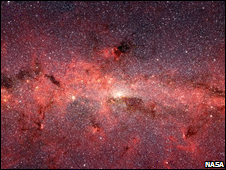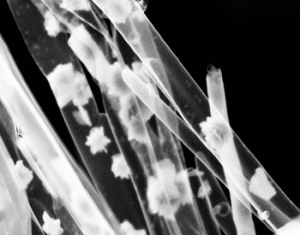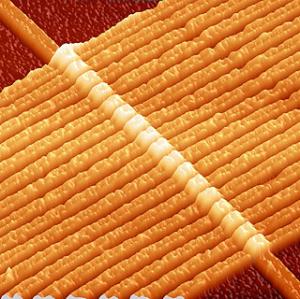December 19th, 2008
admin
Slashdot | Japanese Scientists Claim To Reconstruct Images From Brain Data.
“In a world first, a research group in Kyoto Japan has succeeded in processing and displaying optically received images directly from the human brain. Here’s the Japanese press release for good measure. One step closer to broadcasting your dreams? The research is due to be published today in the US scientific journal Neuron.”
December 19th, 2008
admin
DailyTech – OCZ Unveils Flash Drive with eSATA Connectivity.
OCZ has introduced a new flash drive that does just that. The OCZ Throttle looks like a normal flash drive until the cap comes off and the eSATA adapter is exposed. OCZ promises that the eSATA equipped Throttle is capable of read speeds of up to 90MB/sec and write speeds of up to 30MB/sec.
Faster read and write speeds are great, as long as you have a computer that offers eSATA. However, the majority of computers and notebooks still lack eSATA ports. For this situation, OCZ also equips the drive with a mini USB 2.0 type B port that allows the Throttle to be used with computers lacking the eSATA port needed for full performance.
Versions of the flash drive are available in 8GB, 16GB, and 32GB configurations. The higher performance and high capacity options could make the Throttle a viable backup solution for computer users who normally overlook flash drives because of the typically low capacity and slower USB interface.

December 19th, 2008
admin
DailyTech – Scientists Discover Cloak of Plasma Around Earth.
Scientists have discovered something new in the Earth’s atmosphere described as a warm cloak of plasma. The feature is part of the Earth’s magnetosphere that is key to protecting the planet from solar wind and radiation. The only visible parts of the Earth’s magnetosphere are the aurora borealis and the aurora australis. While most people don’t think much about the magnetosphere, it can have an effect on our lives.
Professor of Physics Rick Chappell from Vanderbilt University told Space.com, “Although it is invisible, the magnetosphere has an impact on our everyday lives. For example, solar storms agitate the magnetosphere in ways that can induce power surges in the electrical grid that trigger black outs, interfere with radio transmissions and mess up GPS signals. Charged particles in the magnetosphere can also damage the electronics in satellites and affect the temperature and motion of the upper atmosphere.”
The new region was discovered after Chappell and other researchers pieced together what they call a “natural cycle of energization” that accelerates low-energy ions in the Earth’s atmosphere into the higher energy levels found in regions of the magnetosphere.
December 19th, 2008
admin
DailyTech – MIT’s DNA Wrapped Nanotubes Look to Fight Disease.
New nanotube design can detect toxins, free radicals, and damaging free radicals
Michael Strano, associate professor of chemical engineering and one of the study’s leaders describes, “We’ve made a sensor that can be placed in living cells, healthy or malignant, and actually detect several different classes of molecules that damage DNA.”
December 19th, 2008
admin
December 12th, 2008
admin
DailyTech – New Methods Combines Lasers and Holograms for Nanoassembly
Laser and hologram method could also be useful for positioning molecules in labs-on-a-chip
When it comes to nanodevices, scientists have no problem cooking up interesting designs. However, when it comes to actually assembling such machines on a nanoscale, it can be a daunting task.
A breakthrough from Purdue University offers up a new technique that may be extremely useful in such nanoassembly. The new method uses lasers and holograms to position multiple nanoparticles within seconds, much faster than previously possible. The method could also be very helpful to labs on the chip, which need to direct tiny molecules to tiny test locations.
The name for the new process — rapid electrokinetic patterning — is a bit overwhelming, but it’s an incredibly promising technology according to researcher Stuart J. Williams. Mr. Williams, who is working with doctoral student Aloke Kumar and Steven T. Wereley, an associate professor of mechanical engineering, states, “It’s potentially a very versatile tool.”

December 12th, 2008
admin
DailyTech – Boeing ABL Fired Through its Beam Control Guidance System
Boeing has successfully fired the laser aboard the ABL aircraft through the onboard laser guidance system
The key to stopping missile attacks is to be able to target and destroy the missiles in the boost phase of their flight before they can reach the target and cause untold damage. The U.S. Missile Defense Agency has been testing the Airborne Laser (ABL) system for several years now.

December 12th, 2008
admin
Striking differences between brains of rich and poor.
A new study in the Journal of Cognitive Neuroscience by researchers from the University of California, Berkeley, has shown for the first time that the brains of low-income children function differently from the brains of high-income kids. UC Berkeley’s Robert Knight says that normal 9 and 10-year-olds differing only in socioeconomic status have detectable differences in the response of their prefrontal cortex, the part of the brain that is critical for problem solving and creativity.
Previous studies have shown a possible link between frontal lobe function and behavioral differences in children from low and high socioeconomic levels, but this new study is the first to directly measure brain activity where there is no issue of task complexity
December 12th, 2008
admin
Respirocyte – Wikipedia, the free encyclopedia
Respirocytes are hypothetical, artificial red blood cells that can supplement or replace the function of much of the human body’s normal respiratory system. Still entirely theoretical, respirocytes measure 1 micrometer in diameter. Respirocytes mimic the action of the natural hemoglobin-filled red blood cells. The design of the spherical nanorobot is made up of 18 billion atoms arranged as a tiny pressure tank. The tank can be filled up with oxygen and carbon dioxide, making one complete transfer point at the lungs, and the reverse transfer at the body’s tissues
Each respirocyte can store and transport 236 times more oxygen than natural red blood cells. It can also monitor carbon acidity in the cell. Filled with these respirocytes, an adult human could hold his/her breath underwater for four hours. That person could also sprint at top speed for at least 15 minutes without taking a breath.
December 12th, 2008
admin
BBC NEWS | Science & Environment | Black hole confirmed in Milky Way
There is a giant black hole at the centre of our galaxy, a 16-year study by German astronomers has confirmed.
They tracked the movement of 28 stars circling the centre of the Milky Way, using two telescopes in Chile.
The black hole, said to be 27,000 light years from Earth, is four million times bigger than the Sun, according to the paper in The Astrophysical Journal.

December 12th, 2008
admin
Carbon Dioxide Found On Extrasolar Planet – Space – redOrbit
NASA’s Hubble Space Telescope has discovered carbon dioxide in the atmosphere of a planet orbiting another star. This is an important step along the trail of finding the chemical biotracers of extraterrestrial life as we know it.
The Jupiter-sized planet, called HD 189733b, is too hot for life. But the Hubble observations are a proof-of-concept demonstration that the basic chemistry for life can be measured on planets orbiting other stars. Organic compounds can also be a by-product of life processes, and their detection on an Earth-like planet may someday provide the first evidence of life beyond Earth.
Previous observations of HD 189733b by Hubble and the Spitzer Space Telescope found water vapor. Earlier this year, Hubble astronomers reported that they found methane in the planet’s atmosphere.
“This is exciting because Hubble is allowing us to see molecules that probe the conditions, chemistry, and composition of atmospheres on other planets,” says Mark Swain of NASA’s Jet Propulsion Laboratory in Pasadena, Calif. “Thanks to Hubble we’re entering an era where we are rapidly going to expand the number of molecules we know about on other planets.”

December 11th, 2008
admin
DailyTech – New Nanomagnets Can Sniff Out Magnetism, Make Nanomemory
Scientists develop new nanotube structures to act as mini-magnet detectors
The new process involves inserting cobalt nanoclusters between 1 nm and 10 nm into a single multi-walled carbon nanotube. As the carbon nanotube is an excellent conductor, it is also sensitive to magnetic activity, such as that of the cobalt nanoclusters. The result is a magnetic nanomaterial, which also can sense electrically other magnetic nanofields.

DailyTech – The Same Chip With Fewer Transistors; HP’s Memristor Changes Everything
HP’s new integral circuit component allows engineers to produce identical logic circuits using fewer transistors and less space


















Recent Comments